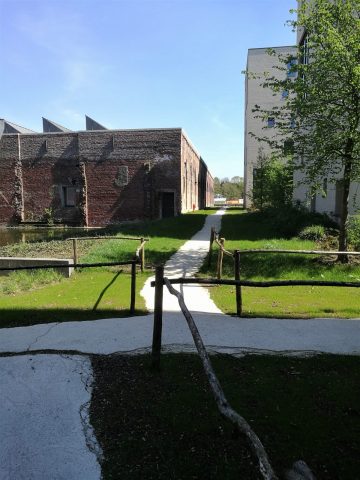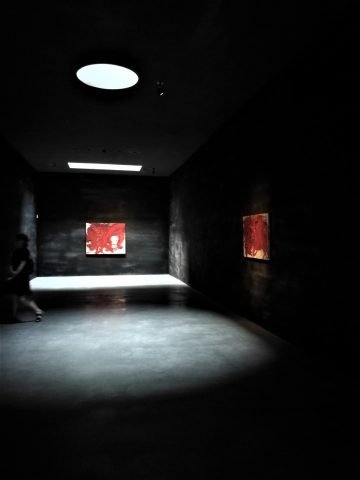Boris Vervoordt and the future of the past-present (an interview)
We visited Kanaal, the new Axel Vervoordt’s city-village, which after almost 20 years of restauration is now completed. We were amazed, so we asked Boris Vervoordt, his son, how it will develop and in which context.
- Kanaal, Antwerp.
- Cubes at Kanaal ©Jan Liégeois
- Kanaal, Antwerp.
- Kazuo Shiraga room at Axel & May Vervoordt Foundation, Kanaal, Antwerp.
- Malting building for Anish Kapoor ©Jan Liégeois
- Anish Kapoor, The red shift, 1995, at Kanaal, Antwerp.
- Kanaal, Antwerp.
- Kanaal, Antwerp.
- Kanaal Masterplan
Kanaal has started to revive just a few months ago. Previously the Albert Malthouse, so was the original name, was the largest brewery and malt house in the Antwerp province (55.000mq). It has now become an hybrid, born out of the entanglement between art, architecture, design. Axel Vervoordt has purchased the entire area in 1998 and thanks to the help of a pool of archictects (Bogdan & Van Broeck, Coussée & Goris e Stéphane Beel) as well as of his family, he has transformed it bit by bit into a sort of habitable museum where, perhaps for the very first time in the world after the unlucky case of Gibellina and the unfinished Comunità Esistenziale of Arcevia (both in Italy), art and artists are the beating heart of a residential area, with a hundred apartments, thought to welcome real inhabitant (not tourists, since we are not far from Antwerp). The pillars of this microcosm which seems to be taking the idea of museum beyond the boundaries we are familiar with, are the rooms of the Axel & May Vervoordt Foundation – whose walls are painted with lava, which is even more natural than the most ecological paints and has an exquisite smell; the 19th century chapel, which houses James Turrells’ ‘Red Shift’ from 1995; a malting building, internally occupied by a vast dome-like metal structure by Anish Kapoor (At the Edge of the World, 1998). Around these pillars, there are the apartments, Axel Vervoordt Company’s offices, artisan workshops, a restoration center, galleries for temporary exhibitions, and the most equipped organic food market you could imagine. Another possible reference would be Paolo Soleri, with his Arcosanti, in Arizona. However that was the vision of an architect now in his 90s, whereas this is the dream of an art dealer and collector, Axel Vervoordt, twenty years younger than Soleri. In order to understand at which point of the dream we are at the moment, we have asked his son Boris, who has the task to bring Kanaal and the sophisticated mindset it expresses into the future.
What is really interesting for us at the moment is the interaction the Kanaal Project is creating with the local audience. We have seen people coming here that we hadn’t seen in a very long time, also people who are not necessarily involved with the arts. They are coming here for the experience. It’s fantastic to see that in such a short period of time Kanal has already managed to build a little role in the local society.
Hence, it’s not only about art people or collectors, it’s about connecting with the area around…
Exactly. The audience is much broader; it’s young and old people, who are interested in art or just want to see this. The platform for the artists got much broader by moving here.
How do you think communication and education in the art enviroment will evolve?
Lately galleries are taking over the education role especially because in Western Europe it’s more difficult for museums to operate, at least on the smaller scale. Thus it’s important that galleries are there for the artists and for putting up shows that are educational, interactive and that people can learn something from. They are trying to bring the barrier down to create an art experience and broaden the audience. It’s not so dissimilar from what Hauser & Wirth is doing in Los Angeles and in Somerset (UK).
Getting good information about art is not that easy in the end.
It’s something you have to keep working on, you are never there. Art education is a life passion. Either you have it or not. And if you have it, you will want to keep learning for the rest of your life.
Do you have plans for the next Venice Biennale, after 5 shows at Palazzo Fortuny?
We have some plans which I hope will materialise in the next few weeks, but not at Palazzo Fortuny. The bond with Palazzo Fortuny is still very strong; we have indeed helped to turn it into a Museum for Mariano Fortuny, as that was the final goal. When we found the building ten years ago though, that was impossible. Many rooms were not accessible and there was a lot of work to do. We had been able to make it.
Do you think that the contemporary art system is in a good shape at the moment?
It’s in a very bizarre shape right now. There is so much happening on different levels. Let’s look at the fairs’ enviroment for instance. Fairs are trying to become like galleries. But it’s also true the opposite, that is to say more and more people are coming back to galleries for the experience and to see art in its context.
How do you think fairs will evolve?
I don’t know. I have the feelings there is an absolute need for the idea of local, that is bringing something on a global level but for a local audience. I believe in very small, concentrated, high quality events. It is important to continue to initiate new audience to the art world. I think that mega fairs are a little bit behind this.
We agree with this. Our perception is that there is a huge audience for antiques and fine arts but younger generations are still buying contemporary art.
I think a lot of younger people are more and more interested in the generation of their parents today which was never the case before. It’s very unusual that people and artists in their 20s and 30s are interested in what was happening after the WWII.
How can fine arts and antiques, which are now undervalued compared to contemporary art, become more appealing?
They are indeed totally undevalued. I believe it comes with the sense of knowledge. It takes much more time to understand quality there. If you are interested in artists that are selling at auctions, a handful of names, then it’s quite easy to figure out what’s good or bad. A choice is staying within the bubble. But it’s much more exciting to go out of that bubble. Certainly this requires time and research. Sometime you need somebody who could be a mentor to you, who can introduce an object or a painting from the past and be able to tell you its mistery.
Communication in this case is very important. Most of the traditional galleries are not really able to present them. The idea we have it’s of something old, out of fashion. As soon as you create the proper enviroment they can turn contemporary and show their value.
Well, not every old master painting has that capacity. It typycally works with masterpieces. It doesn’t work with some followers of monday morning painting. That is just boring and really out of fashion. We are constantly looking for amazing old masters but it’s not easty to find pieces we really love.
There’s more than people think.
Much more. Anyway, when something comes to the market it is relatively cheap. You buy a fantastic painting for much less than you would pay a Mark Bradford.
Are you collector yourself?
I started collecting photography when I was in my 20s and now I collect artists that I became passionate about and that I represented. At home there are many pieces by artists we represent together with pieces by artists that I met before and I was inspired by. The most serious work as a collector however is really within the family for what has become The Axel & May Vervoordt Foundation.
Are you keeping the original idea of the collection?
Absolutely and then I bring in my own experience. I think it’s fundamental to always add new ideas.
Are you planning to expand your gallery in China?
We do have a gallery in Hong Kong, which has been opened for six years now. It’s a small space where we can show the artists. The next step will be moving to a more expanded space in HK. We are also focusing on mainland China now.
How would you describe the chinese art enviroment?
I’ve been going to China since 1980s, and I witnessed this exciting start in Beijing. Back then we weren’t however active as a gallery. I was buying some old Chinese art. Then we opened the gallery in Hong Kong as we felt it was necessary for our artists to have representation there. It was the new frontier. We went there and we were happy about that. However, we saw a large crowd which was mainly interested in big names, in buying and selling, in how much a painting was worth at auctions. It was more about investing than collecting art. But we continued with our program
. Every time we have a new artist we organise lectures with artists or historians talking about the artist. We really take the educational role quite seriously. Now you see it has a place and people from mainland China start to understand and respect us for that.
November 25, 2020









